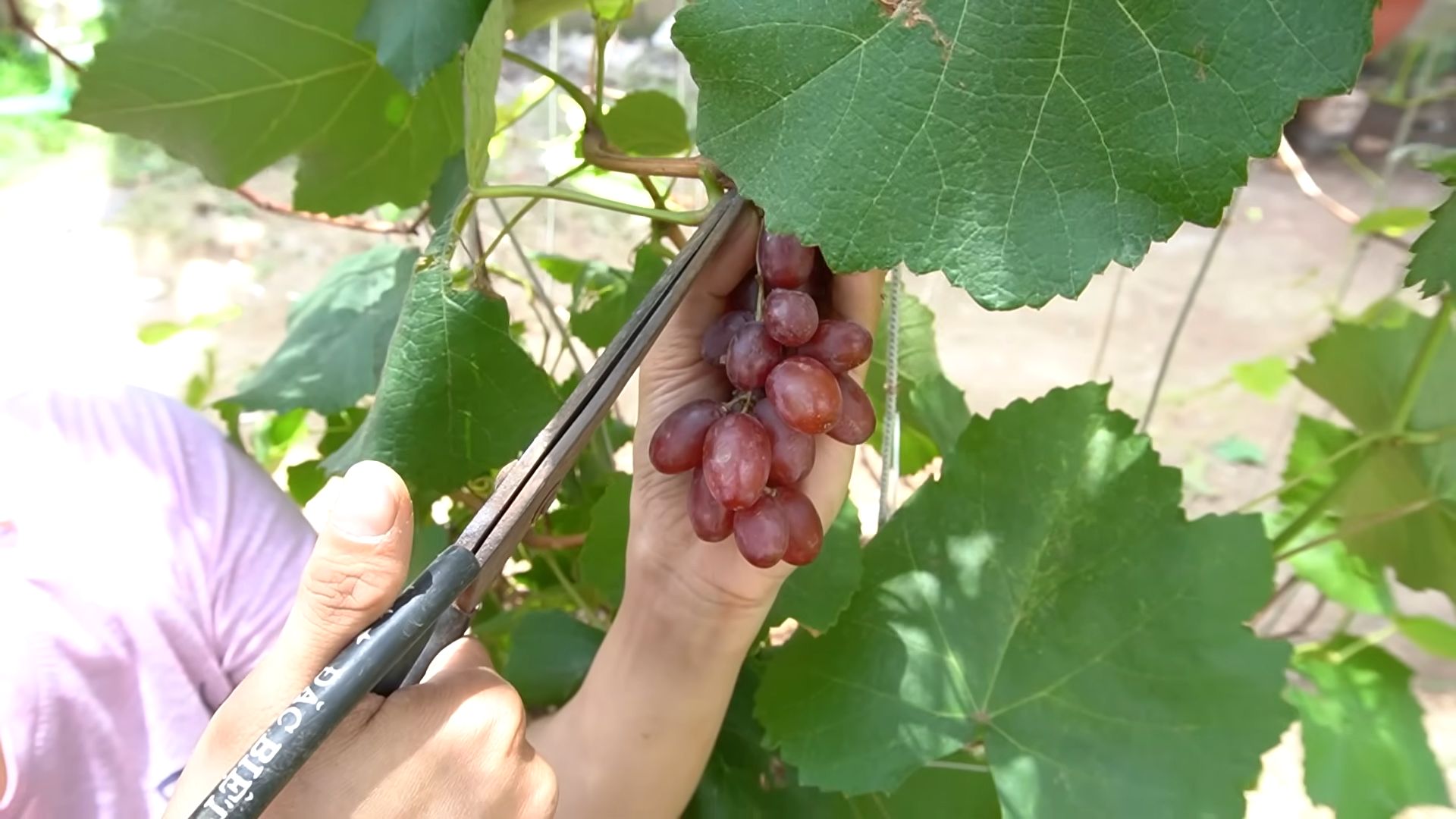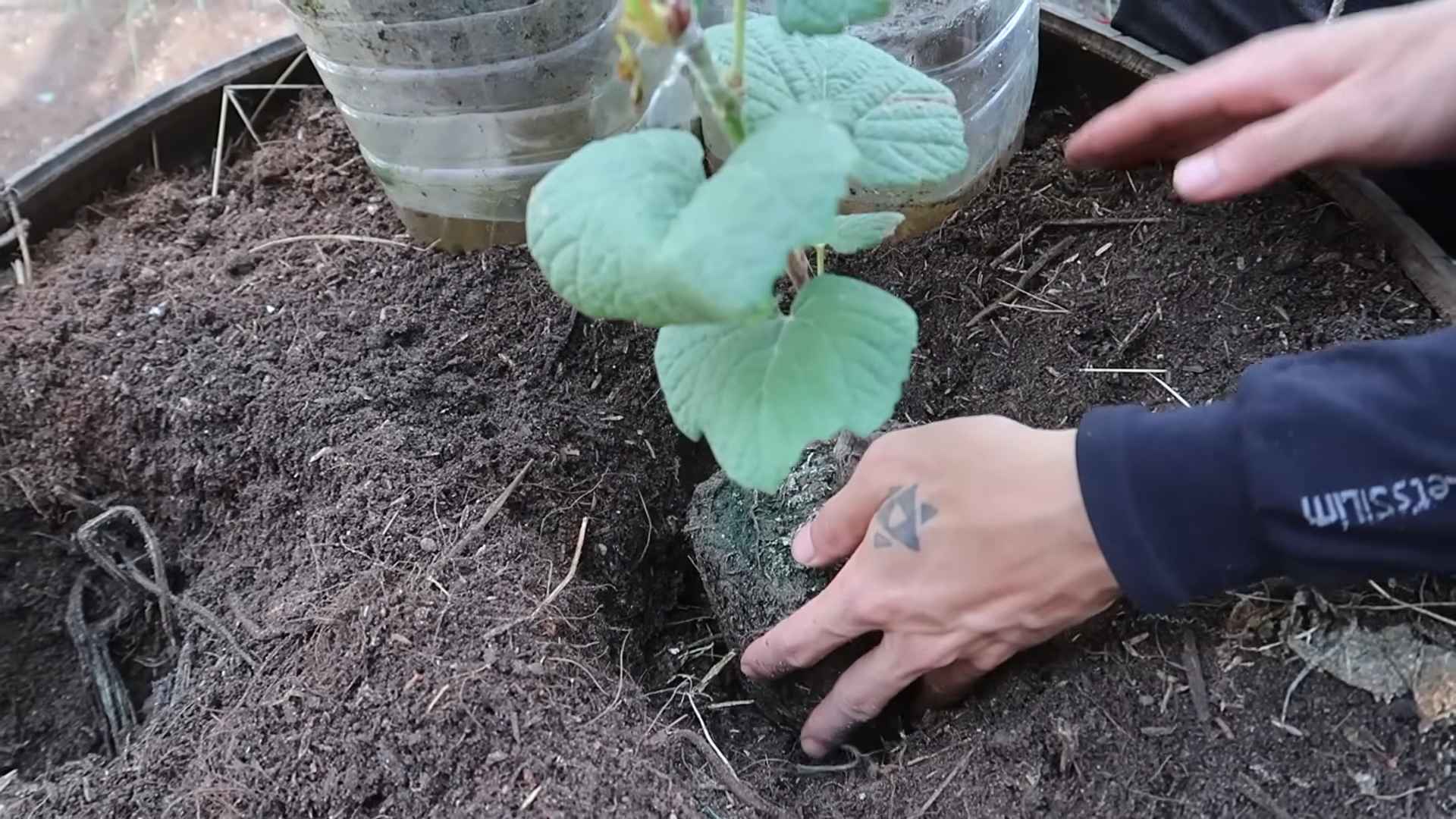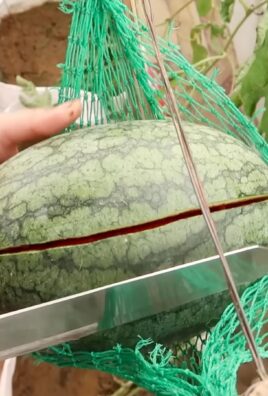Grow Backyard Grapes Easily? Absolutely! Imagine stepping into your backyard and plucking juicy, sun-ripened grapes straight from the vine. Sounds like a dream, right? Well, it doesn’t have to be! For centuries, cultivating grapes has been a cherished tradition, dating back to ancient civilizations who revered them not only for their delicious fruit but also for the exquisite wines they produced. From the vineyards of the Roman Empire to the sun-drenched slopes of modern-day California, the allure of growing grapes has endured.
But you don’t need a sprawling vineyard to enjoy the fruits of your labor. I’m here to tell you that you can grow backyard grapes easily, even if you have limited space or gardening experience. This DIY guide is packed with simple, effective tricks and hacks that will empower you to cultivate your own thriving grapevine. Why spend a fortune on store-bought grapes when you can have a bountiful harvest right outside your door? Plus, there’s nothing quite like the satisfaction of nurturing a plant from a tiny seedling to a fruit-bearing beauty. Let’s get started and transform your backyard into a grape-growing paradise!

Growing Backyard Grapes: A Beginner’s Guide to a Bountiful Harvest
Okay, so you want to grow your own grapes? Awesome! It’s totally doable, even if you don’t have a green thumb. I’m going to walk you through everything you need to know to get started, from choosing the right variety to pruning like a pro (well, almost!). Get ready for some delicious, homegrown grapes!
Choosing the Right Grape Variety
This is probably the most important step, so let’s get it right! Not all grapes are created equal, and what thrives in California might not survive in Maine. Consider your climate, space, and what you want to *do* with your grapes.
* Climate Considerations: Find out your USDA plant hardiness zone. This will tell you which grape varieties are likely to survive your winters. Look for varieties that are specifically recommended for your region. Local nurseries are a great resource for this!
* Space Available: Grapes need room to spread! Some varieties are more vigorous than others. If you have a small backyard, consider a more compact variety or plan to prune aggressively.
* Intended Use: Are you dreaming of making your own wine? Or are you more interested in fresh eating grapes for snacking and jams? Wine grapes tend to be smaller and have thicker skins, while table grapes are larger and juicier.
* Disease Resistance: Some grape varieties are more resistant to common diseases like powdery mildew and black rot. Choosing a disease-resistant variety can save you a lot of headaches (and fungicide!).
Some popular and relatively easy-to-grow varieties include:
* Concord: A classic American grape, great for juice, jams, and jellies. Very hardy.
* Niagara: Another American variety, similar to Concord but with a lighter, sweeter flavor.
* Reliance: A seedless table grape that’s very cold-hardy.
* Thompson Seedless: The most popular seedless table grape, but it needs a warmer climate.
* Mars Seedless: A red seedless table grape that’s disease-resistant and cold-hardy.
Preparing the Planting Site
Grapes need sunshine and well-drained soil. Seriously, well-drained soil is crucial! Soggy roots are a grape vine’s worst enemy.
* Sunlight: Grapes need at least 6-8 hours of direct sunlight per day. The more, the better!
* Soil Drainage: Perform a drainage test. Dig a hole about a foot deep and fill it with water. If the water doesn’t drain within 24 hours, you have a drainage problem. You might need to amend the soil with organic matter or consider planting in raised beds.
* Soil pH: Grapes prefer a slightly acidic soil pH of around 6.0-7.0. You can test your soil pH with a home test kit or send a sample to your local extension office for professional testing.
* Soil Amendment: Amend the soil with plenty of compost or well-rotted manure before planting. This will improve drainage, fertility, and overall soil health.
Planting Your Grape Vines
Okay, you’ve got your grape variety picked out and your planting site prepped. Let’s get those vines in the ground!
1. Timing: The best time to plant grape vines is in early spring, after the last frost, or in late fall, before the ground freezes.
2. Spacing: Space your grape vines according to the variety and the type of trellis system you’ll be using. Generally, table grapes need about 8-10 feet between vines, while wine grapes can be spaced closer together, around 6-8 feet.
3. Digging the Hole: Dig a hole that’s twice as wide as the root ball and just as deep.
4. Preparing the Roots: Gently loosen the roots of the grape vine before planting. If the roots are circling around the pot, gently tease them apart.
5. Planting: Place the grape vine in the hole, making sure the top of the root ball is level with the surrounding soil.
6. Backfilling: Backfill the hole with the amended soil, gently tamping it down as you go.
7. Watering: Water the newly planted grape vine thoroughly.
8. Mulching: Apply a layer of mulch around the base of the vine to help retain moisture and suppress weeds. Use organic mulch like straw, wood chips, or shredded bark. Keep the mulch a few inches away from the trunk of the vine to prevent rot.
Trellising Your Grape Vines
Grapes are vines, so they need something to climb on! A trellis provides support, improves air circulation, and makes it easier to prune and harvest your grapes. There are many different types of trellis systems you can use, but here are a couple of popular options:
* Single-Wire Trellis: This is the simplest and most economical option. It consists of a single wire stretched between two posts.
* Two-Wire Trellis: This provides more support than a single-wire trellis and is better suited for heavier grape varieties. It consists of two wires stretched between posts, one above the other.
* Arbor: If you want to add a decorative element to your backyard, consider training your grape vines over an arbor.
Building a Simple Single-Wire Trellis:
1. Gather Your Materials: You’ll need two sturdy posts (4×4 treated lumber is a good choice), wire (12-gauge galvanized wire is recommended), wire tensioners, and concrete mix.
2. Set the Posts: Dig holes for the posts about 2-3 feet deep. Space the posts according to the recommended spacing for your grape variety.
3. Pour Concrete: Mix the concrete according to the manufacturer’s instructions and pour it into the holes around the posts. Make sure the posts are plumb (perfectly vertical) before the concrete sets.
4. Attach the Wire: Once the concrete has cured, attach the wire to the posts. Use wire tensioners to keep the wire taut.
Caring for Your Grape Vines
Now that your grape vines are planted and trellised, it’s time to give them some TLC!
* Watering: Water your grape vines regularly, especially during dry periods. Young vines need more frequent watering than established vines. Aim for about 1 inch of water per week.
* Fertilizing: Fertilize your grape vines in the spring with a balanced fertilizer. Follow the manufacturer’s instructions for application rates. Avoid over-fertilizing, as this can lead to excessive vegetative growth and reduced fruit production.
* Weed Control: Keep the area around your grape vines free of weeds. Weeds compete with the vines for water and nutrients. You can use mulch, hand-weeding, or herbicides to control weeds.
* Pest and Disease Control: Monitor your grape vines regularly for signs of pests and diseases. Common grape pests include Japanese beetles, grape phylloxera, and grape berry moth. Common grape diseases include powdery mildew, black rot, and downy mildew. Treat any problems promptly with appropriate pesticides or fungicides. Organic options are available!
* Pruning: This is where things get a little more complicated, but don’t worry, I’ll break it down for you!
Pruning Grape Vines: The Key to a Good Harvest
Pruning is essential for grape production. It controls the size and shape of the vine, improves air circulation, and promotes fruit production. Pruning can seem intimidating at first, but once you understand the basics, it’s not that difficult.
Understanding Grapevine Growth:
* One-Year-Old Wood: This is the wood that grew last year. It’s usually brown and relatively smooth. Fruit is produced on shoots that grow from one-year-old wood.
* Two-Year-Old Wood: This is the wood that grew the year before last. It’s usually thicker and more textured than one-year-old wood.
* Permanent Wood: This is the trunk and main branches of the vine. It’s several years old and very thick.
Pruning Methods:
There are two main pruning methods for grapes: cane pruning and spur pruning. The best method for you will depend on the variety of grape you’re growing.
* Cane Pruning: This method involves removing most of the one-year-old wood and leaving only a few canes (long, slender shoots) with a certain number of buds. Cane pruning is typically used for grape varieties that produce fruit on buds that are farther away from the main trunk.
* Spur Pruning: This method involves cutting back the one-year-old wood to short spurs (short, stubby shoots) with only a few buds each. Spur pruning is typically used for grape varieties that produce fruit on buds that are closer to the main trunk.
General Pruning Guidelines:
* Timing: Prune your

Conclusion
So, there you have it! Growing backyard grapes easily is not just a pipe dream; it’s an achievable reality with a little planning, preparation, and the right DIY techniques. We’ve walked you through the essential steps, from selecting the perfect grape variety for your climate and soil to providing the necessary support and care for a thriving vine.
Why is this DIY approach a must-try? Because it empowers you to cultivate your own delicious, healthy grapes right in your backyard, offering a rewarding experience that connects you with nature and provides a sustainable source of fresh fruit. Forget the expensive, often bland, store-bought grapes. Imagine plucking juicy, sun-ripened grapes straight from your vine, knowing exactly where they came from and how they were grown. The taste difference is remarkable!
But the benefits extend beyond just flavor. Growing your own grapes is a fantastic way to reduce your carbon footprint, as you’re eliminating the transportation and packaging associated with commercially grown produce. It’s also a great way to get some exercise and fresh air while tending to your vines. Plus, a healthy grape vine can add beauty and shade to your backyard landscape.
Don’t be afraid to experiment with variations! Try different training methods, such as the cordon or cane system, to see which works best for your space and grape variety. Consider adding companion plants around your vines to attract beneficial insects and deter pests naturally. You can even explore different ways to use your homegrown grapes, from making your own juice and jam to drying them into delicious raisins.
And remember, growing backyard grapes easily is a journey, not a destination. There will be challenges along the way, but with patience and persistence, you’ll be rewarded with a bountiful harvest. So, grab your gardening gloves, choose your favorite grape variety, and get started today!
We’re confident that you’ll find the experience of growing your own grapes incredibly rewarding. We encourage you to try this DIY trick and share your experiences with us. Let us know what varieties you’re growing, what challenges you’ve faced, and what successes you’ve achieved. Share your photos and tips in the comments below – we’d love to hear from you! Together, we can create a community of backyard grape growers, sharing knowledge and inspiring others to embark on this fruitful adventure.
Frequently Asked Questions (FAQ)
What is the best time of year to plant grape vines?
The best time to plant grape vines is typically in early spring or late fall, when the vines are dormant. This allows the roots to establish themselves before the heat of summer or the cold of winter sets in. Planting in early spring gives the vines a full growing season to develop, while planting in late fall allows the roots to slowly acclimate over the winter months. However, if you live in a region with mild winters, you may be able to plant grape vines at other times of the year as well. Just be sure to provide adequate water and protection from extreme temperatures.
How much space do I need to grow grape vines?
Grape vines need plenty of space to grow and thrive. A general rule of thumb is to space vines about 8 to 10 feet apart in rows that are 10 to 12 feet apart. This allows for adequate sunlight and air circulation, which are essential for healthy growth and fruit production. However, the exact spacing may vary depending on the grape variety and the training system you choose. Some varieties, such as table grapes, may require more space than others. If you’re using a trellis or arbor, be sure to factor in the size of the structure when determining the spacing.
What kind of soil is best for growing grapes?
Grapes prefer well-drained soil that is slightly acidic to neutral in pH (between 6.0 and 7.0). The soil should be rich in organic matter and have good drainage to prevent root rot. Before planting, it’s a good idea to test your soil to determine its pH and nutrient levels. You can amend the soil with compost, manure, or other organic materials to improve its fertility and drainage. Avoid planting grapes in heavy clay soil or soil that is prone to waterlogging.
How often should I water my grape vines?
Grape vines need regular watering, especially during the first year after planting. Water deeply and infrequently, allowing the soil to dry out slightly between waterings. During hot, dry weather, you may need to water more frequently. However, avoid overwatering, as this can lead to root rot. Once the vines are established, they are relatively drought-tolerant and may not need as much watering. Monitor the soil moisture and water when the top inch or two of soil feels dry to the touch.
Do I need to prune my grape vines?
Yes, pruning is essential for maintaining the health and productivity of grape vines. Pruning helps to control the size and shape of the vine, improve air circulation, and promote fruit production. The best time to prune grape vines is in late winter or early spring, before the buds begin to swell. There are several different pruning methods, such as cane pruning and spur pruning, so it’s important to choose the method that is best suited for your grape variety and training system.
What are some common pests and diseases that affect grape vines?
Grape vines can be susceptible to a variety of pests and diseases, including aphids, spider mites, Japanese beetles, powdery mildew, downy mildew, and black rot. To prevent pest and disease problems, it’s important to choose disease-resistant grape varieties, provide good air circulation, and practice good sanitation. Regularly inspect your vines for signs of pests or diseases and take action promptly if you notice any problems. You can use organic pesticides or fungicides to control pests and diseases, but be sure to follow the instructions carefully.
How long does it take for grape vines to produce fruit?
Grape vines typically take 2 to 3 years to begin producing fruit. The first year after planting, the vines will focus on establishing their root system. In the second year, they may produce a small amount of fruit, but the yield will be limited. By the third year, the vines should be producing a more substantial crop. However, the exact time it takes for grape vines to produce fruit may vary depending on the grape variety, the growing conditions, and the care you provide.
Can I grow grapes in containers?
Yes, you can grow grapes in containers, but it’s important to choose a large container that is at least 20 gallons in size. Use a well-draining potting mix and provide adequate support for the vines to climb. Container-grown grapes will need more frequent watering and fertilization than grapes grown in the ground. Choose a grape variety that is well-suited for container growing, such as dwarf or compact varieties.
How do I know when my grapes are ripe?
The best way to tell if your grapes are ripe is to taste them. Ripe grapes will be sweet and juicy, with a slightly soft texture. The color of the grapes will also change as they ripen, depending on the variety. For example, green grapes will turn yellow or amber, while red grapes will turn a deeper shade of red or purple. You can also check the sugar content of the grapes using a refractometer.
What can I do with my homegrown grapes?
There are many things you can do with your homegrown grapes! You can eat them fresh, make juice, jam, jelly, or wine. You can also dry them into raisins or use them in baking and cooking. Grapes are a versatile fruit that can be enjoyed in a variety of ways. Experiment with different recipes and find your favorite ways to use your homegrown grapes.





Leave a Comment